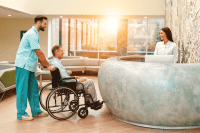In February 2006, our hospital, Northwest Community Hospital, was awarded Magnet status. If someone asks for a short explanation of how we attained it and how we are maintaining it, the answer is easy: Collaboration.
Closing the research gap
To achieve Magnet status for a hospital, the chief nurse executive needs to create, foster, and sustain a practice environment that integrates nursing research into the every day world of nursing practice for registered nurses (RNs) at all levels in the organization. To promote nursing research in our community hospital, we established a Nursing Research Council that included direct-care RNs from various nursing units and advanced practice nurses in 2002. Two years later, we attended a Magnet Roundtable Consortium of local hospitals that were pursuing Magnet status. Chief nurse executives, research representatives, and direct-care RNs from several hospitals came together to support and assist each other in the pursuit of Magnet status by sharing best practices and fostering collaboration. We learned that all the hospitals faced a common challenge: integrating research into the community hospital setting.
As a result of the roundtable, research representatives from six hospitals formed a research consortium to provide a forum for hospitals seeking or maintaining Magnet status. The consortium dealt with such issues as professional networking, identifying best practices, supporting nursing education, and promoting collaborative research initiatives among the hospitals.
At the first Chicagoland Research Consortium meeting, Magnet project coordinators, nurse researchers, research coordinators, and direct-care RNs agreed to meet quarterly and rotate meeting sites, so representatives could highlight research or evidence-based projects at their hospital. We also agreed to collaborate on and present educational programs.
Since that first meeting, our educational programs have included Ethics in Research, Research in the Pediatric Intensive Care Unit, Fundamentals of the Consent Process, Creating the Ideal Bedside Science Environment, Conducting a Multi-site Research Study, Overview of Research Related to Restraints, Hormone Therapy: The Controversy and Evidence, and Development of a Research Fellowship Program.
Successful outcomes
Collaboration, networking, and continuing growth keep the consortium successful. We encourage members to bring guests, and we’ve grown from 6 to 17 hospitals. We also encourage members to share their project success stories. Each meeting allows 1 hour of networking followed by education.
Shared educational programs are one of the most important outcomes of the consortium. Each hospital invites direct-care RNs to join the networking and educational components of the meeting. This helps get direct-care RNs involved in the research dialogue with their peers and nurse researchers. Direct-care RNs gain confidence and enhance their communication skills by presenting evidenced-based projects or research posters.
Organizing professional poster presentations and sharing research information increase the collaboration among the member hospitals. When a hospital achieves Magnet status, we honor the consortium representatives, and we encourage other members to stay committed.
Sharing the success of consortium members is the energy and momentum for the group. Team-building activities, such as welcoming new members, sharing best practices, and exchanging business cards, foster collaboration.
Potential barriers
Despite all the success, consortium members have started to talk about potential barriers. Ironically, all the barriers are directly tied to our success—or more specifically, to our growth:
• As the number of hospitals increases, distance and travel time may make a central meeting site seem more practical than our current rotation of sites.
• Expanding membership means that research interests and educational needs will likely become more divergent, and full participation in the consortium may suffer.
• Communication among the members may become more difficult. To address this concern, we are considering whether we should develop a website.
• Growth may require a more formal charter, and we may need to collect dues to provide funds for national speakers or a website.
Keys to success
Of our 17 member hospitals, 7 have reached Magnet status. The consortium’s contributions to nursing practice and nursing research have been integral to our member organizations achieving and sustaining Magnet status. And the commitment and support of the chief nurse executives and the collaboration of all members have been the keys to those contributions.
Selected references
American Nurses Association. Magnet Recognition Program Application Manual 2005. Washington, DC: American Nurses Association; 2005.
American Nurses Association. Scope and Standards for Nurse Administrators. 2nd ed. Washington, DC: American Nurses Association; 2004.
Eulberg P, Herrmann S, Torres, M. Working together to embrace Magnet nursing excellence. Poster presentation at American Organization of Nurse Executives, March 2005, Chicago, Illinois.
Turkel M, Reidinger G, Ferket K, Reno K. An essential component of the Magnet journey: fostering an environment for evidence-based practice and nursing research. Nurs Adm Q. 2005;29(3):254-262.
Kathleen Ferket, MSN, RN, CPNP, is Director of Children’s Services at Northwest Community Hospital in Arlington Heights, Illinois. Gloria Reidinger, MS, RNC, APN, is a Clinical Nurse Specialist at Northwest Community Hospital. Marian Turkel, PhD, RN, is a Research Consultant at Northwest Community Hospital.

















